Running a laundromat
In this section, we cover some of the setup, staging and logistics based on the experience of our iterations of the science communication laundromat.
This is broken down into:
- Comfort + care the set-up in terms of accommodation, facilitation, food, and shared values
- Facilitation. planning + time including planning the stages and example runsheets with rough timings
- Props + space how we have set up the space to help with the stages of the laundromat process
Generally, this website assumes that you are facilitating a group laundromat experience of some kind (residential, or online), with some pointers for online or blended options.
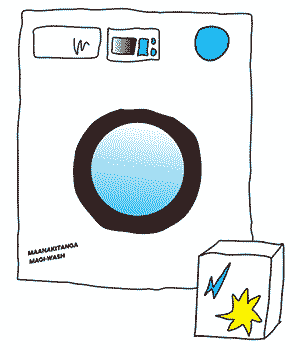
Comfort + care
The laundromat is premised on helping scientists to be reflexive and thoughtful about their engagement.
For those who operate in research areas that have a high degree of social licence and are well-supported in seeking to do science communication, the laundromat won't necessarily be emotionally taxing. Sometimes though, reflexivity means grappling with issues that are less than comfortable. This might be about the culture in which participants operate, perhaps with diversity, equity, and inclusion shortcomings. Sometimes, the realisation that others might disagree on the ethics of a particular scientific endeavour might be uncomfortable. Or the identification of power imbalances within research and engagement can be challenging.
All of this means that a safe and comfortable space is vital, and we see the provision of that space as central to our ethos, or something that exists in our values…
Shared values
In New Zealand, we might refer to ‘manaakitanga’, which loosely translates as hospitality, and entails showing respect, generosity, and care for the people who are attending your place, or using your services. For Te Pūnaha Matatini, maanakitanga is a core value, which extends to mutual respect and reciprocity. We see a spirit of manaakitanga as vital to the laundromat’s success.
We have found that because our participants, though broad in disciplines and practices all belong to an organisation with clear values, we have been lucky that the social dynamics have always helped create a safe and supportive environment. You can read more about the values that come with our organisational associations in the about>values section.
Different disciplinary communities may vary according to their theories, methodologies, and codes, and institutions may have similar variances. If your participants don’t enter with a shared culture and agreed-upon norms and values, you may need a process to get people on the same page before you start. This might be a discussion you can have at stage 1.
The venue for in-person laundromats
Our in-person laundromats have been held outside the (usually university) environments where our participants normally work, and have been run on a multi-day residential basis. We recognise the privilege in being funded by an organisation that pays the costs for our scientist-communicators to attend, and that most have the autonomy to schedule their time to allow it.
Being away from the distractions of the normal working day helps people mode-shift, and we have consistently heard that participants have managed to stay off their devices and away from the call of the office partly because of the offsite nature of the laundromats, and the analogue nature of the activities.
We have tended to use venues that are set up with comfortable but relatively basic accommodation, such as ‘retreat centres’ that are like a nicer version of a school camp! This might be shared rooms and shared bathrooms, but we try and give people their own room for sleeping if possible.
Communal spaces
The key communal spaces are somewhere to eat together, a shared space with a projector, somewhere to suspend a washing line, set up washing machines and room to spread out to work. And, ideally, if you have project groups, breakout spaces where they can work together. We have found that people gravitate to sitting on the floor, or on sofas (or outside) in preference to regular tables and chairs if there is a choice.
Transport
We have also been lucky in having support at Te Pūnaha Matatini to arrange other logistics like travel. For many, having had someone arrange those details for them is a welcome change and something they'd often be doing themselves (or for other people). This contributes to the feeling of entering a place where the participants’ needs are cared for.
The venue for online laundromats
For an online workshop, participants have both joined from one space (a shared office, or a room booked in their institution) and we have dialed in, or they have all joined from different locations. Both times, we have sent some resources as a ‘laundromat-in-a-box’ – zines; a washing line and pegs; prompts; and wheel/hanging out timeline worksheets. Our experience was largely determined by the level of COVID restriction, but the communal nature of coming together (even if we are not there in person) is preferable, if it’s safe to do so. That seems to be because some of the resources work best with physical, communal input, and the material process of writing and pinning things in a very lo-fi way helps underline the iterative nature of the process.
In-person catering
As you will see from the schedules below, eating together plays a large part in the laundromat experience! We've found it is vital for the sense of maanakitanga, and meal-breaks become a valuable time to keep turning over the ideas from the laundromat sessions.
We usually have an external caterer, but the attendees have had some responsibility for either assisting with prep or clearing up. We go 100% vegetarian (and have had no pushback on this), with other dietary needs catered for. We have hot drinks available on a self-serve basis all the time. No alcohol is provided, but people are invited to bring their own.
Online catering
For our online laundromats, we have provided lunch deliveries so that a group can work together and eat together. It’s one way of making the laundromat a little bit different to other meetings, especially if they are being held in a familiar work environment.

Eating together and plentiful tasty vegetarian food have been a hallmark of our in-person laundromats
You will need:
a shared space with a projector, somewhere to suspend a washing line, and room to spread out to work
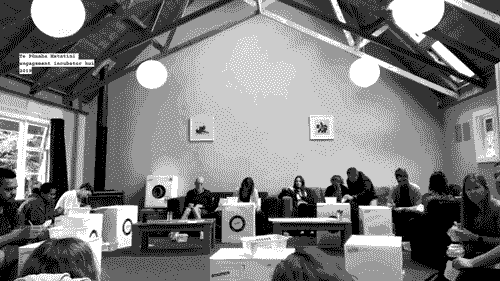
A working space at the first residential laundromat in 2019
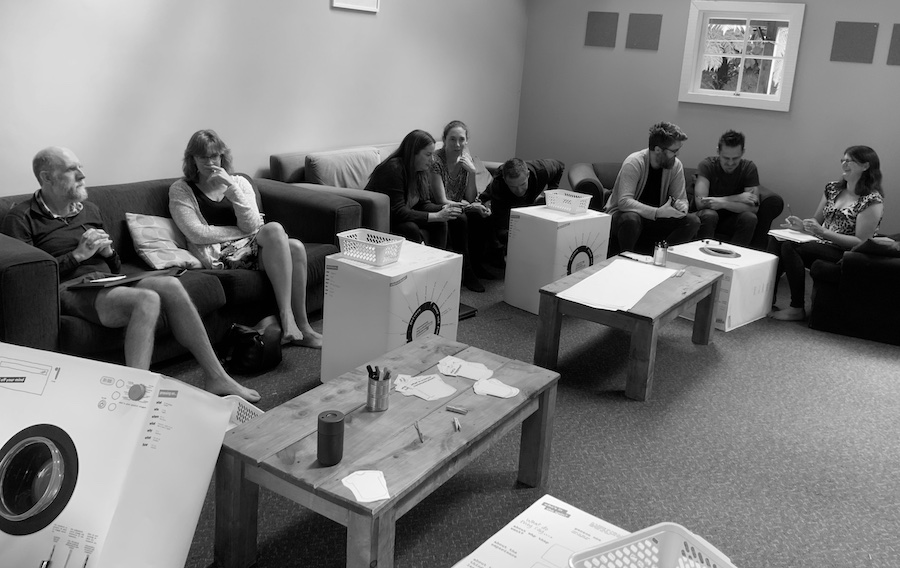
Participants working in groups on sofas in a laundromat space
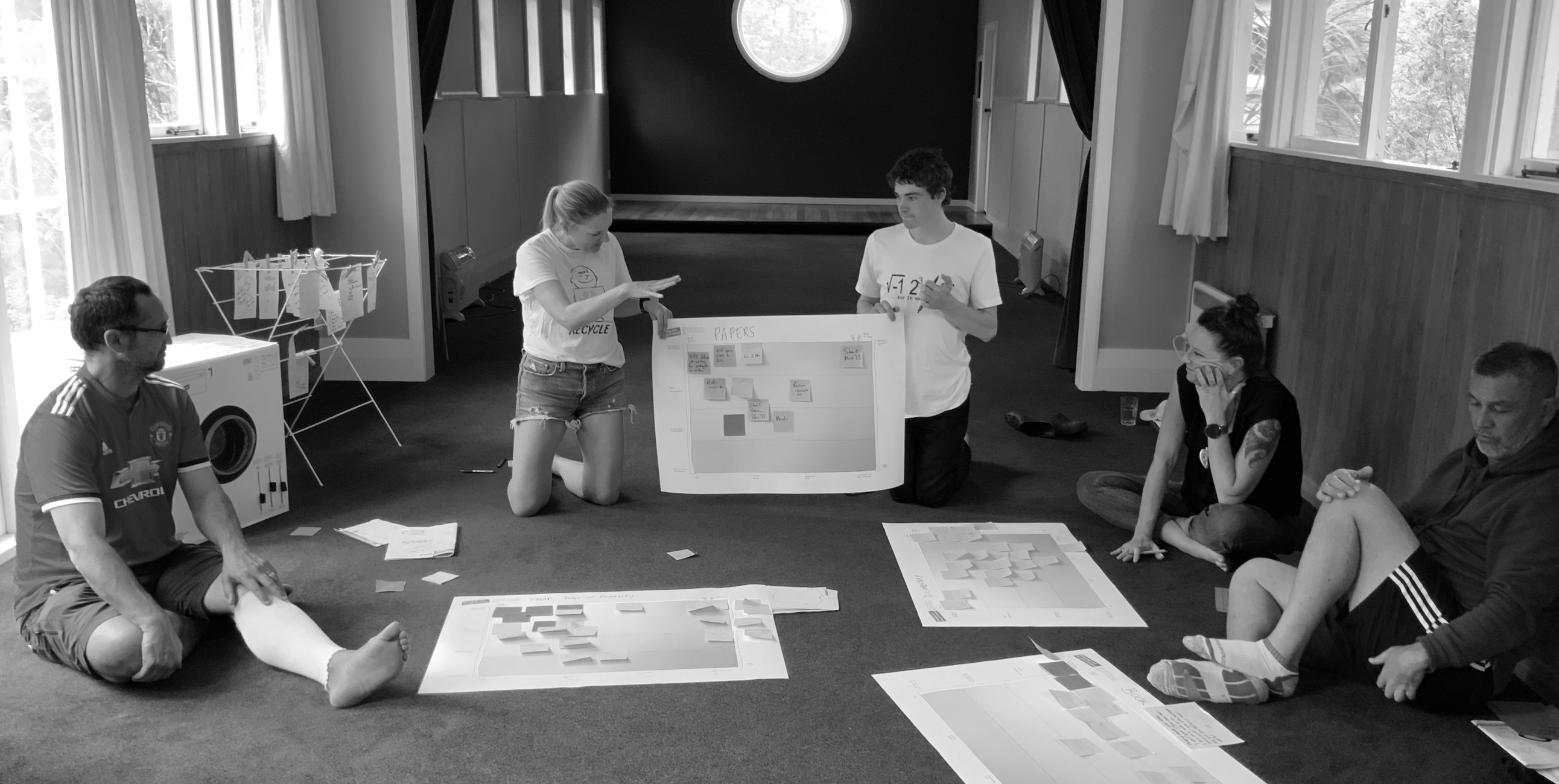
Group working on the floor
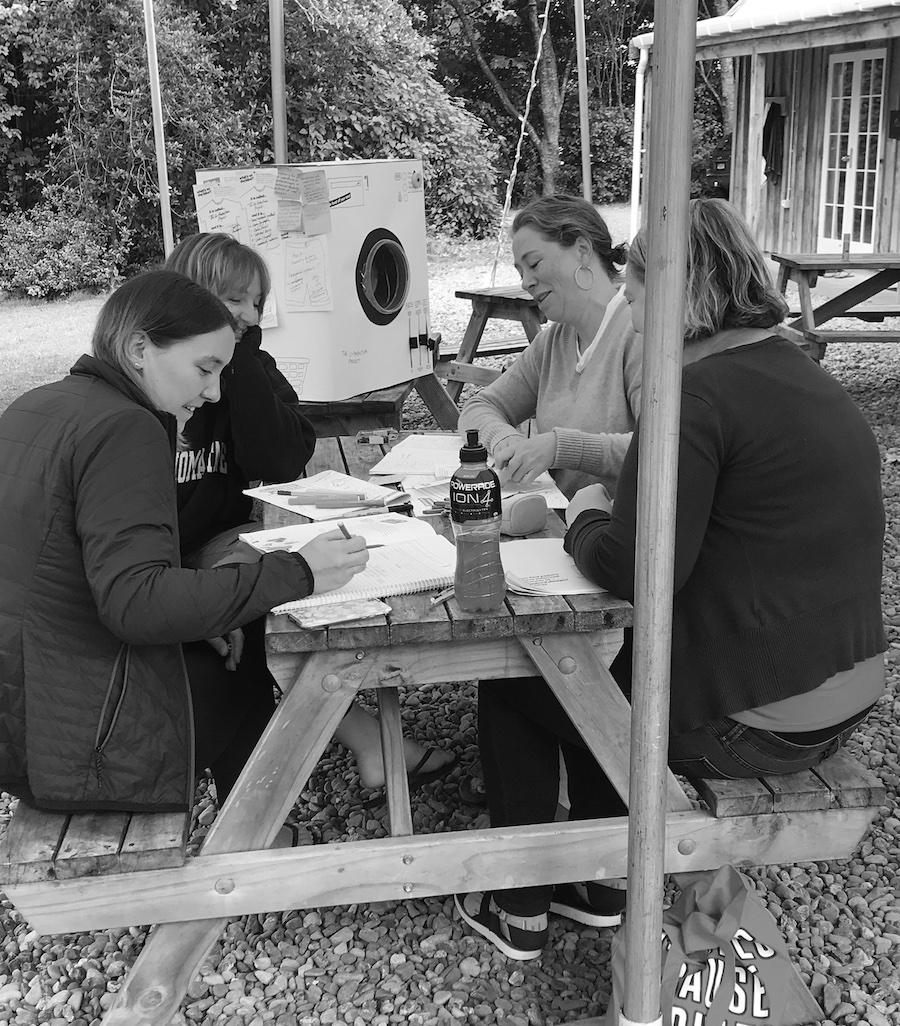
Working outside with a washing machine
Facilitation, planning + time
Facilitation
We have run our laundromats with a principal facilitator (Rhian), and a secondary facilitator (Jo) who also prepares the materials and the staging and looks after the space. We have also had an observer and critical friend (Maja) who helped us gather fieldnotes and was vital in aiding us to become more reflexive about our engagement practice, so we could loop our ‘doing’ back into our thinking: a process that is both informed by public engagement theory and embeds the practice of doing it (we also published about it too, with a hope that theory could inform practice could inform theory…). A facilitator needs to have an understanding of science communication theory and practice in order to elevate this from a workshop that helps scicomm engagement planning (which obviously still has value, but doesn’t help with meeting our objectives of connecting the scientist-communicators with some of the wider PES or science in society concepts).
We’ve also had support to book the travel and logistics for the participants, and venues and caterers who have been on the ball and helped us run smoothly.
Participant numbers
With our two-person facilitation team, we have done in-person laundromats with up to 20 people. We have also had mixed-size groups together, where some groups are up to six people, and there is a mix of individuals and pairs.
A large laundromat works if there are a couple of big projects where multiple people work together. Equally, a cohort of individual scientists works well, as they can interact with each other even if their projects are really different.
It can feel unbalanced when you have groups of very different sizes as it is hard to calibrate the amount of time that projects share and present for. Ideally, keeping the overall number of people to an absolute maximum of 20, and the sizes of groups similar works well.
We have also (especially online) done single-project laundromats with groups of 4–6 people. These also work well. A multi-project online laundromat would take a huge amount of energy and planning!
We have also had an observer and critical friend … aiding us to become more reflexive about our engagement practice, so we could loop our ‘doing’ back into our thinking: a process that is both informed by public engagement theory and embeds the practice of doing it (we also published about it too, with a hope that theory could inform practice could inform theory…).
Using individual stages
We have conceptualised the laundromat as a structured programme where the steps build on each other, sometimes overlapping and revisiting content (as captured in the zine workbook). It can feel repetitive, but that is very much by design, and participants have frequently noted that similar questions with a subtly different angle rinse out more and different information each time. However, we have also used some individual steps as standalone exercises:
- We have used a version of the pre-laundromat survey with several previous workshop groups, including questions about roles and responsibilities within a project team. This has proved useful for bringing to the fore, especially in teams that have the intention to work in a transdisciplinary way, where assumptions about responsibility for communication and engagement lie.
- ‘Name tag’ can be a useful icebreaker in any circumstance where there is a degree of trust and safety amongst participants. Even in less overtly reflexive situations, such as in a class with students, it still works (though expect inherently fewer personal disclosures and more focus on things like hobbies).
- We have used tailored stage 2: peg ‘em up prompts in one-day project sessions to help get everyone on the same page, and work out the expectations and assumptions team members have about the engagement activities.
- The wheel at step four has been used in shorter engagement workshops with research teams successfully.
Though other steps like step 5 ‘what's in the spin’ audiences and messages have not been used in isolation, they could certainly be used as a repeat exercise related to a new engagement activity for a project team who have already done a full process, or practitioners who want to refresh areas of their practice.
Laundromat time structure
In-person sessions
In-person, we have run these in various time-block combinations, sometimes starting in the afternoon or evening then having a full day and a half day; sometimes two very full days and a night, or similar variations. Overall, we have found that it comes out as four or five half-day chunks, with room for a bit of downtime and for project teams to talk about other things (like their actual scientific research) in planned gaps (so the social and non-laundromat time does not eat into the washing time!).
Online sessions
Online, we have tended to do a series of structured virtual meetings over a number of weeks. Our earlier iterations were very hands-on, where we did the stages in real-time with us as facilitators on the call. They were valuable, but very time-intensive. Later, we tried shorter check-ins where we debriefed and then briefed in exercises but largely let the group self-organise and either meet together face-to-face between online check-ins, or stay online together to work through it without us. There are pros and cons to each, and you probably have a sense of the dynamic that will work best for your participants.
Below are example runsheets for both situations:
the steps build on each other, sometimes overlapping and revisiting content… they could certainly be used as a repeat exercise related to a new engagement activity for a project team who have already done a full process, or practitioners who want to refresh areas of their practice.
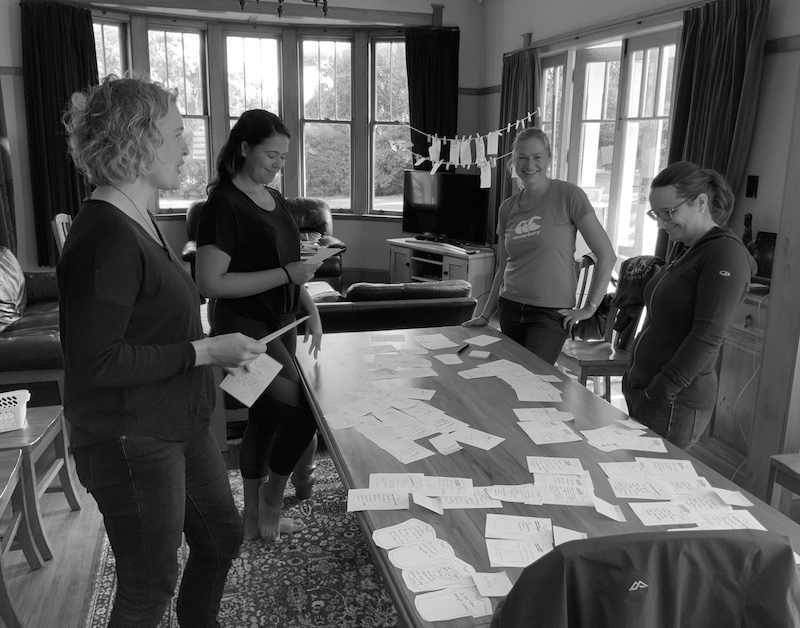
A project team use custom peg ‘em up prompts at a one-day hui
Example runsheet: in-person laundromat
This is an example runsheet over three days giving a rough idea of how much time to dedicate to each section.
You can also view this on a google sheet here (so you can copy it for your own use – there are two tabs, one for in-person and one for online):
| time | activity | stage | detail | notes |
| Day 1 | ||||
| 12:30 | Lunch | |||
| 2:00–3.30 PM | Intro section | 1. Gathering up the laundry | Opening karakia (Whakataka te hau) | A karakia is a Māori incantation and formal greeting or start to a meeting that sets the scene, and in a spiritual sense, is used to increase the goodwill of a gathering, so as to increase the likelihood of a favourable outcome. Though sometimes called prayers they can be secular, and in New Zealand are frequently used to start a meeting showing respect to Māori culture. This won’t be the appropriate action everywhere, but some way of setting the session off with a respectful tone is useful |
| Introduce and hand out the zine workbooks | ||||
| ‛Name tag’ | Set the scene. You can hand out separate sheets, ask people to cut it out of the zine workbook, or pin a separate sheet into the zine. Allow about five minutes for each side. Assure people that they can keep adding as they go | |||
| Sharing ‛Name tag’ | Depending on the number, expect about five minutes per person. Make sure people know the only thing they have to disclose is what’s on the front: anything else is optional. It can be helpful to invite people to ‛tag’ from person to person based on shared attributes (places, interests etc) | |||
| ‘Drawing it out‛: you and your engagement | Hand out A3 sheets, or have these pinned into the zine workbook if you want people to be able to ‛peg these up’. Coloured pens are useful. Keep it light and playful and allow about 10 minutes | |||
| ‛Engagement Is…’ | Hand out A4 sheets, or have these pinned into the zine worbook if you want people to be able to ‛peg these up’ | |||
| Sharing ‛Drawing it out’ and ‛Engagement is…’ | Expect this to take around 40 minutes. After each person has explained their drawing and their statement, invite them to peg them on a washing line | |||
| 3:30–3.45 PM | Setting the cycle survey | If appropriate, you might want to point out how the laundromat has been tailored based on a pre-cycle survey, or ask people if they have any reflections on what they said at that point now they’ve had further time to soak it | ||
| 3:45–4:10 PM | Afternoon tea | |||
| Free time | Settle into rooms, touch base with your colleagues, check emails, etc | |||
| 6:00 PM | Dinner | |||
| 8:00 PM | 2. Sort the laundry | SciComm 101 | Depending on your setting, doing this in an informal, comfortable space with post-dinner coffee or drinks can be nice, and help the conversation flow. Invite people to chip in with their own expertise and experiences. We’ve usually had some experienced people in the mix | |
| time | activity | stage | detail | notes |
| Day 2 | ||||
| From 7:30 AM | Breakfast | |||
| 9:00 AM | Introduce the washing machines | Hand out the washing machines to groups; reiterate that the steps are also in the zone workbooks. This should only take five minutes | ||
| 2. Sort the laundry | ‘Get in on the Garments peg ‛em up prompts’ | The envelope of prompts can either go in the zine, or, we like to hand them over in a mini washing basket alongside pens, sticky notes and pins. Invite people to download onto the prompts, and pin them to the side of the washing machine | ||
| 3. Choose the settings | Invite people to give their washing machine a project name. This can be a working title for the project, or you can name the washing machine in a silly way playing on the washing machine vibe | |||
| Set the sliders | The silders on the front are a bit clunky! Let groups talk about this and see if they agree for a few minutes. A group discussion can be useful | |||
| Set the cycle | If the project the participants are washing is tied to a set event, the number of days in the cycle can be up to the event is complete. Or it can be more open-ended. No right or wrong answer here, other than to help get a sense of specific event projects vs. longer-term strategic/overarching engagement plans | |||
| 10:30 | Morning tea | |||
| 11:00 AM | 4. Soak + spin | ‘What’s in the spin?’ wheel | Allow 10 minutes per section (not per ‘spoke’!); 30 mins for the whole activity. Reiterate some things can live in more than one place. The zine workbook has further guidance. Get projects to report back to the whole group (in five or so minutes each) | |
| 12:30 | Lunch | |||
| 5. Rinse and wring | Who’s in the Spin? | Audiences and messages matrix on top of machine. The zine also has pages for this, so multi-person groups can do different audiences alongside their key three. Allow up to ten minutes per audience as a quick sprint-wash | ||
| What *is* the spin? | We normally brief this in but suggest it is an activity that can be done separately. This might vary depending on context | |||
| Feedback on audiences + messages | We usually allow quite a lot of feedback and sharing time here, but it might be more appropriate to do the 'What *is* the spin?' and have a shorter group chat | |||
| 3:00 PM | afternoon tea | |||
| 3:30 | 6. Hanging out | Timeline | By this time of day, people might be flagging. Sometimes, we brief this in but allow people to choose if they want to crack on, get together with their group in the evening, or even push it over to the next day. | |
| 5:00 PM | Close and free time | A walk, swim, or nap is good here! | ||
| 6:30 PM | Dinner | |||
| 8:00 PM | 7. Fold + press | Talk through rest of the zine workbook: ‘How’s it stacking up?’ evaluation; freshly laundered, and a heads-up about the presentations (feeding back their stage 8). Then a relaxed discussion: let it go where it goes | ||
| time | activity | stage | detail | notes |
| Day 3 | ||||
| From 7:30 AM | Breakfast | |||
| 9:00 AM | Suggest people pack out of their rooms before we start | 7. Fold and press 8. Freshly laundered |
Prepare their Stage 8: ‘Freshly laundered’ next steps | Reflect on evaluation, revisit or complete their Stage 6: Hanging out timeline (depending on how the end of day 2 went); get their three ‘next steps’ into their zines |
| 10:00 AM | Sharing and discussion | Depending on how the back end of day 2 and the morning went will dictate the extent of the discussion. At a minimum, give their ‘elevator pitch’ distillation of the project and their three next steps. If you can, photograph these (or note them down) for later follow up | ||
| 12:30 | Lunch | Debrief and decompress | A quick lunch, then we usually do a round-the-room pre-departure recorded ‘how did you find it?’ session to gather feedback | |
| 1.30 PM | Depart | |||
Example runsheet: online laundromat
This is an example runsheet over five sessions giving a rough idea of how much time to dedicate to each section.
You can also view this on a google sheet here (so you can copy it for your own use – there are two tabs, one for in-person and one for online):
| time | activity | stage | detail | notes |
| Session 1 | ||||
| Beforehand | In advance: send zine workbooks and ‘laundromat-in-a-box pack’ with washing line, A1 worksheets for the wheel and hanging out priorities washing line for stages 4 and 6. Ask participants to do the survey (depending on needs, you might ask them to send you images of these in advance of the first meeting) | |||
| 9:00 AM | Intro section | 1. Gathering up the laundry | Opening karakia (Whakataka te hau) | A karakia is a Māori incantation and formal greeting or start to a meeting that sets the scene, and in a spiritual sense, is used to increase the goodwill of a gathering, so as to increase the likelihood of a favourable outcome. Though sometimes called prayers they can be secular, and in New Zealand are frequently used to start a meeting showing respect to Māori culture. This won’t be the appropriate action everywhere, but some way of setting the session off with a respect tone is useful |
| Open the box! | Introduce the zines and materials; get them to hang the washing line | |||
| ‘Name tag’ | This can be used as a general icebreaker. | |||
| Sharing ‘Name tag’ | Depending on the number, expect about five minutes per person. Make sure people know the only thing they have to disclose is what's on the front: anything else is optional. It can be helpful to invite people to 'tag' from person to person based on shared attributes (places, interests etc) | |||
| Debrief ‘setting the cycle survey’ |
|
|||
| ‛Drawing it out’: you and your engagement and ‘Engagement is…’ | Brief in these stages, then leave them to do it | |||
| Morning tea | ||||
| 10:30 AM | Sharing ‛Drawing it out’ and ‘Engagement is…’ | Expect this to take around 30 minutes. After each person has explained their drawing and their statement, invite them to peg them on a washing line that they have put up in their space. Take pictures! | ||
| 11:00 AM | 2. Sort the laundry | ‘Get in on the Garments peg ‘em up prompts’ | Brief in‘Get in on the Garments peg ‘em up prompts’. The envelope of prompts should be in the box, alongside pens, sticky notes, and pegs. Between now and when you next meet, they should get together and download onto the prompts, and peg them up | |
| Close | Closing karakia | |||
| time | activity | stage | detail | notes |
| Session 2 | ||||
| 9:00 AM | Welcome | Opening karakia then brief in | Explain that you're going to do SciComm 101, then talk about their washing line of prompts | |
| 9:10 AM | 2. Sort the laundry | SciComm 101 | Give the SciComm 101 presentation, inviting questions or comments as you go so it can be conversational. The zine workbook has copies of the slides. Finish wtih a Q+A, and see if anyone has different views (if this hasn't come up already) | |
| 9:45 AM | 2. Sort the laundry | ‘Get in on the Garments peg ‘em up prompts’ | Ask the participants to talk you through anything from their washing line that they found surprising. Ask if SciComm 101 changes any of their thoughts on the project | |
| 10:15 AM | 3. Choose the settings + 4. Soak + spin | Set the cycle, set the sliders, ‘What’s in the spin?’ wheel | Brief in set the sliders, set the cycle, and the ‘Whats in the spin?’ wheel | |
| 10:30 AM | Morning tea | Leave the participants to it, with catering, to work together | ||
| Close | Closing karakia (can be done before you leave) | |||
| time | activity | stage | detail | notes |
| Session 3 | ||||
| 9:00 AM | Welcome | Opening karakia | ||
| 9:10 AM | 3. Choose the settings + 4. Soak + spin | Set the cycle, set the sliders, ‘What’s in the spin?’ wheel | Debrief the sliders (were they all in agreement?) and the wheel | |
| 10:00 AM | 5. Rinse and wring | Who’s in the Spin? | Audiences and messages. The zine also has pages for this, so multi-person groups can do different audiences. Allow up to ten minutes per audience as a quick sprint-wash | |
| 10:30 AM | Morning tea | Leave the participants to it, with catering, to work together | ||
| 11:00 AM | 5. Rinse and wring and 6. Hanging out | Who’s in the Spin?, ‘What *is* the Spin?’ | Debrief audiences and messages matrix and brief in What *is* the spin? (the deeper dive into messages). This is one we leave for them to explore if they find it helpful. Brief in the project planner Hanging out priorities washing line (they need to look at all their previous stages to make sure they cover all bases here) | |
| Close | Closing karakia | |||
| time | activity | stage | detail | notes |
| Session 4 | ||||
| 9:00 AM | Welcome | Opening karakia | ||
| 6. Hanging out | Priorities washing line | Debrief the priorities washing line. This is more about them than you, so just note if things sound realistic and point out any elements that might have come from previous exercises like the wheel. Do they need to revisit any parts? | ||
| 10:00 AM | 7. Fold + press and 8. Freshly laundered | Briefing | Talk through rest of the workbook zine: ‘How’s it stacking up?’ evaluation; freshly laundered, and a heads-up about the presentations (feeding back their stage 8) in a last session | |
| 10:30 AM | Morning tea | Closing karakia | ||
| time | activity | stage | detail | notes |
| Session 5 | ||||
| 9:00 AM | Welcome | Opening karakia | ||
| 9:10 AM | 7. Fold + press and 8. Freshly laundered | Feed back Stage 8:‛Freshly laundered’ next steps | Reflect on how things are rinsing, then at a minimum, give their ‘elevator pitch’ distillation of the project and their three next steps. If you can, photograph/screencapture these (or note them down) for future followup | |
| 10:00 AM | Sharing and discussion | A round-the-room pre-departure recorded ‘how did you find it?’ session to gather feedback | ||
| 10:30 AM | Morning tea | Closing karakia | Final informal chat; see if they want an additional check-in | |
Props + space
Tuning the personality of any experience to the audience and context can increase participant comfort and engagement. That is the intent of staging the laundromat space with props that foreground the metaphors that liken thinking about and planning scicomm to a laundry cycle. It’s playful, it’s definitely not a ‘normal science space’, and the lo-fi-ness invites unresolved, in-progress thinking.
This draws on ideas from scenography: a practice rooted in creating performance environments in theatre, but increasingly recognised outside that domain; more specifically, ideas of ‘social scenography’ (Hächler, 2015) that come from from a museum context. Hachler says ‘social scenography’ in museum exhibition design is how the ‘social, interactive, communicative’ dimensions are enhanced through scenographic means. On one end of the spectrum is a curated space; on the other, a social space. Elements such as ‘invitation to touch’; static vs. ephemeral work; ‘white cube’ vs. laboratory, and ‘visitor observer’ vs. ‘visitor actor’ mark out the poles, and calibrating these is how a temporary installation can become a ‘space’ through what Hächler (Hächler, 2015, p. 353) terms ‘the intersection of content-based conception, spatial arrangement, and social praxis/activity on the part of the visitors’. Which all goes to say, cardboard washing machines have a purpose!
A washing machine is not essential: all the exercises can be done via the zine and worksheets, but we have found it fun to have a box as the canvas for a project. Most of the exercises have a home on the washing machine and seeing them become covered in notes and scribbles as the laundromat develops is useful to see how far a project has come. Boxes are bulky and create scale and impact with relative ease (and cheapness). Associated props are easy to come by all add up to a designed deliberateness.
You can find details on constructing a washing machine in the resources section. You’ll also find a key component there: the zine workbook, which as well as housing the content to help participants through the steps also reinforces the visual language of the space.
This is how we have brought the props and materials together in our laundromats:

1: washing lines and pegs
A washing line (which is also included in a laundromat-in-a-box) gives a place to hang up completed stage 1 tasks (1.3: ‘Drawing it out‛ you and your engagement).
2: ironing boards and laundry baskets
An ironing board with the cover removed becomes a handy portable table, and plastic ‘laundry baskets’ for each group are a useful way of keeping odd bits of paper together.
3: cardboard washing machines
the washing machine itself is made from a cardboard box, with a plastic container for a door, and a milk bottle top knob. The sliders are foldback clips.
4: garment-shaped paper
Having garment-shaped prompts or extra paper helps milk the ‘hanging out’ metaphor!
5: drying racks
A cheap drying rack and pegs gives extra hanging space for prompts or notes.
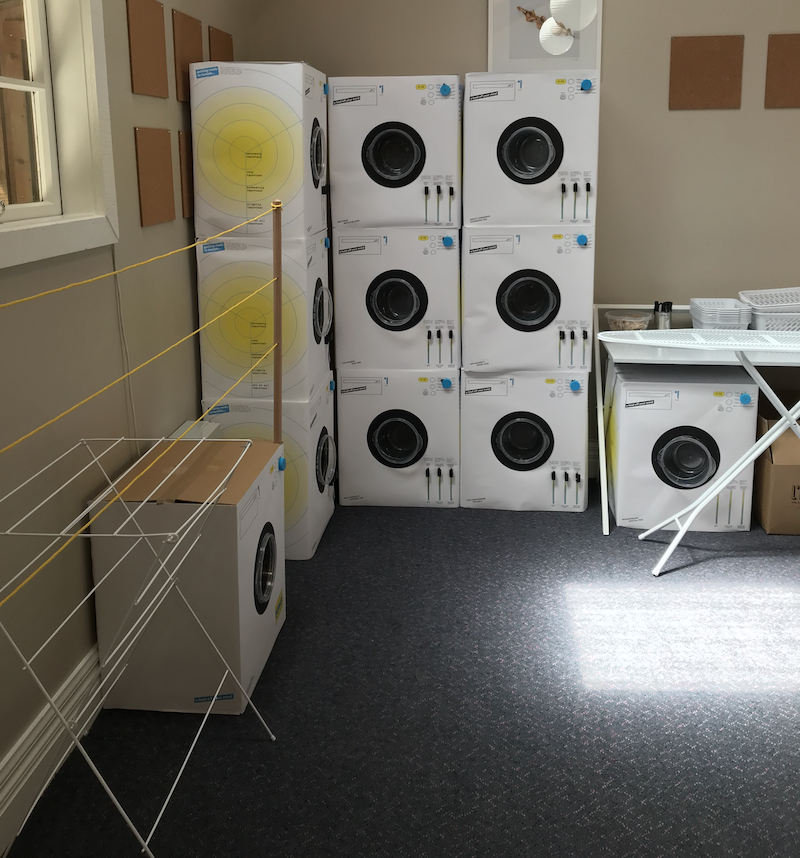
A laundromat set up ready to go before participants arrive
The props that we’ve used are surprisingly portable. When we did the conference laundromats, we got 12 washing machines, an ironing board, drying rack plus a portable washing line, baskets and posters in a bicycle box, just under the weight limit to fly domestically in New Zealand!
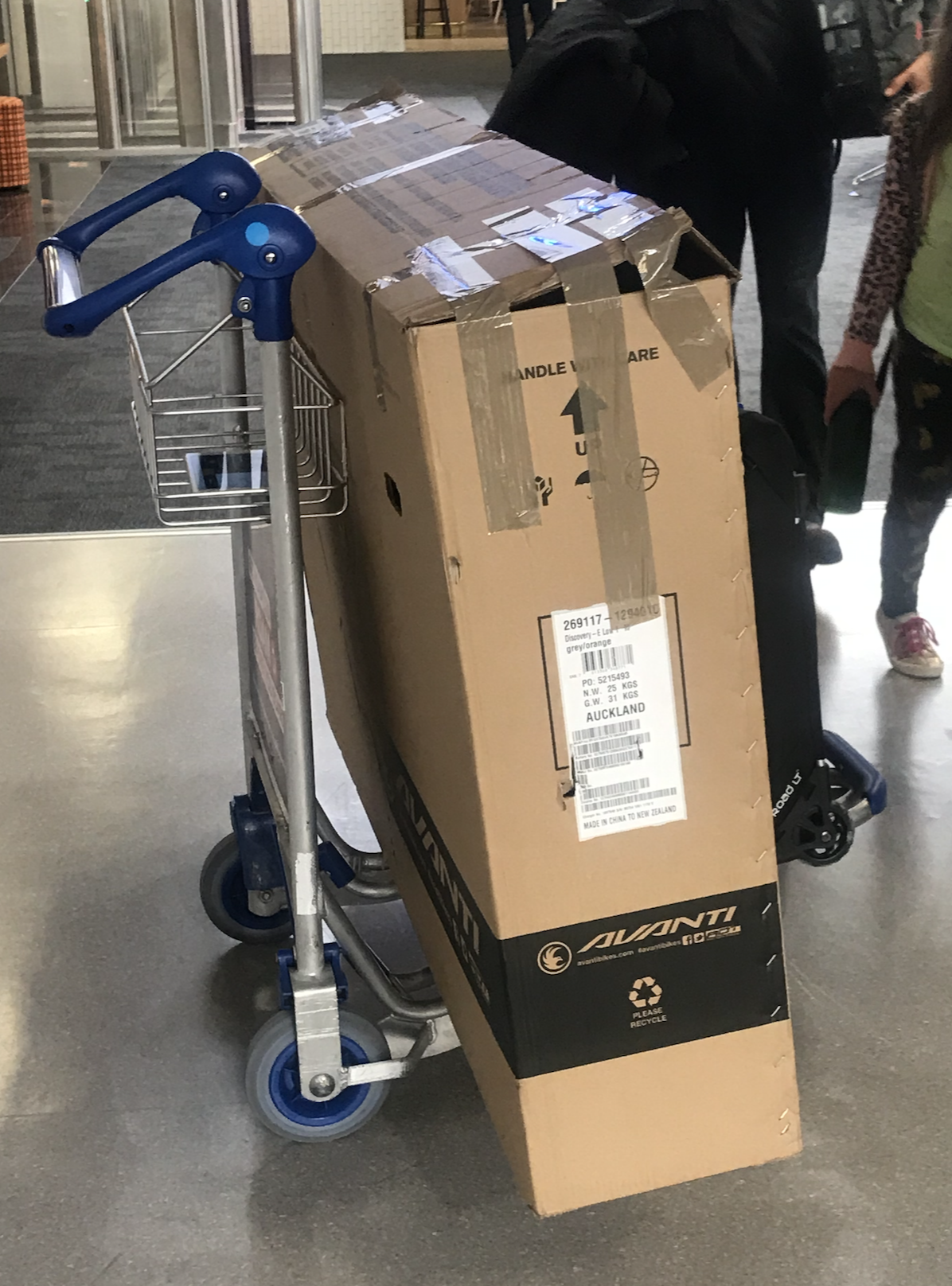
A box containing a full-sized laundromat!